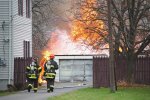knjelectric
Member
- Location
- portage, michigan usa
I have a customer that bought a used commercial oven without telling me. He is
within his rights to do this. The problem is it is 3ph 208 v. His service is 3ph 240v.
This unit has a nameplate rating of 200 a. The 2 conveyor motors can be rewired to the higher voltage. My question is how do I compute the current draw at the higher voltage? If I use straight math and think the higher voltage the lower current it would be 173 a. But if I use ohms law I come up with app. 240 a. I have talked with a few good electricians and we are all scratching our heads. One gentleman
brought up the point that if you increase the voltage on a filiment (light bulb) you will shorten the life of the filiment or burn the filiment (resistor) out. We need a learned person to put this problem to bed. We all have grey hair and dont need any more. Thank you in advance. Jim KNJ Electric p.s. I have thought of a step down transformer also but still need to know the math to get an accurate draw on the service
within his rights to do this. The problem is it is 3ph 208 v. His service is 3ph 240v.
This unit has a nameplate rating of 200 a. The 2 conveyor motors can be rewired to the higher voltage. My question is how do I compute the current draw at the higher voltage? If I use straight math and think the higher voltage the lower current it would be 173 a. But if I use ohms law I come up with app. 240 a. I have talked with a few good electricians and we are all scratching our heads. One gentleman
brought up the point that if you increase the voltage on a filiment (light bulb) you will shorten the life of the filiment or burn the filiment (resistor) out. We need a learned person to put this problem to bed. We all have grey hair and dont need any more. Thank you in advance. Jim KNJ Electric p.s. I have thought of a step down transformer also but still need to know the math to get an accurate draw on the service

